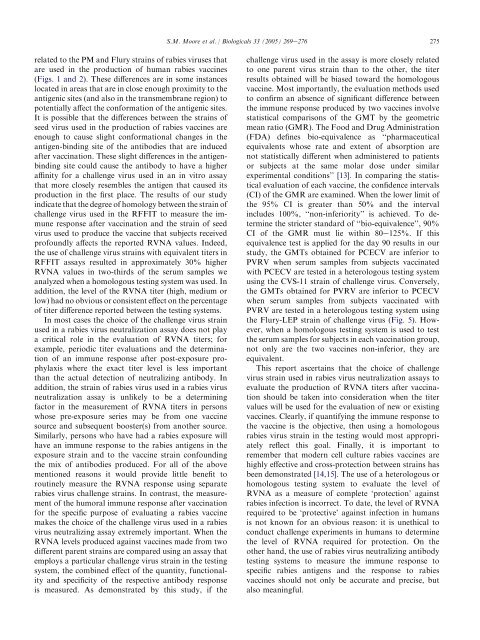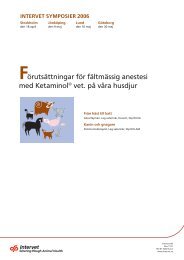KVÄLLSSYMPOSIUM 2008 Vaccinering av hund och katt
KVÄLLSSYMPOSIUM 2008 Vaccinering av hund och katt
KVÄLLSSYMPOSIUM 2008 Vaccinering av hund och katt
Create successful ePaper yourself
Turn your PDF publications into a flip-book with our unique Google optimized e-Paper software.
elated to the PM and Flury strains of rabies viruses that<br />
are used in the production of human rabies vaccines<br />
(Figs. 1 and 2). These differences are in some instances<br />
located in areas that are in close enough proximity to the<br />
antigenic sites (and also in the transmembrane region) to<br />
potentially affect the conformation of the antigenic sites.<br />
It is possible that the differences between the strains of<br />
seed virus used in the production of rabies vaccines are<br />
enough to cause slight conformational changes in the<br />
antigen-binding site of the antibodies that are induced<br />
after vaccination. These slight differences in the antigenbinding<br />
site could cause the antibody to h<strong>av</strong>e a higher<br />
affinity for a challenge virus used in an in vitro assay<br />
that more closely resembles the antigen that caused its<br />
production in the first place. The results of our study<br />
indicate that the degree of homology between the strain of<br />
challenge virus used in the RFFIT to measure the immune<br />
response after vaccination and the strain of seed<br />
virus used to produce the vaccine that subjects received<br />
profoundly affects the reported RVNA values. Indeed,<br />
the use of challenge virus strains with equivalent titers in<br />
RFFIT assays resulted in approximately 30% higher<br />
RVNA values in two-thirds of the serum samples we<br />
analyzed when a homologous testing system was used. In<br />
addition, the level of the RVNA titer (high, medium or<br />
low) had no obvious or consistent effect on the percentage<br />
of titer difference reported between the testing systems.<br />
In most cases the choice of the challenge virus strain<br />
used in a rabies virus neutralization assay does not play<br />
a critical role in the evaluation of RVNA titers; for<br />
example, periodic titer evaluations and the determination<br />
of an immune response after post-exposure prophylaxis<br />
where the exact titer level is less important<br />
than the actual detection of neutralizing antibody. In<br />
addition, the strain of rabies virus used in a rabies virus<br />
neutralization assay is unlikely to be a determining<br />
factor in the measurement of RVNA titers in persons<br />
whose pre-exposure series may be from one vaccine<br />
source and subsequent booster(s) from another source.<br />
Similarly, persons who h<strong>av</strong>e had a rabies exposure will<br />
h<strong>av</strong>e an immune response to the rabies antigens in the<br />
exposure strain and to the vaccine strain confounding<br />
the mix of antibodies produced. For all of the above<br />
mentioned reasons it would provide little benefit to<br />
routinely measure the RVNA response using separate<br />
rabies virus challenge strains. In contrast, the measurement<br />
of the humoral immune response after vaccination<br />
for the specific purpose of evaluating a rabies vaccine<br />
makes the choice of the challenge virus used in a rabies<br />
virus neutralizing assay extremely important. When the<br />
RVNA levels produced against vaccines made from two<br />
different parent strains are compared using an assay that<br />
employs a particular challenge virus strain in the testing<br />
system, the combined effect of the quantity, functionality<br />
and specificity of the respective antibody response<br />
is measured. As demonstrated by this study, if the<br />
S.M. Moore et al. / Biologicals 33 (2005) 269e276<br />
challenge virus used in the assay is more closely related<br />
to one parent virus strain than to the other, the titer<br />
results obtained will be biased toward the homologous<br />
vaccine. Most importantly, the evaluation methods used<br />
to confirm an absence of significant difference between<br />
the immune response produced by two vaccines involve<br />
statistical comparisons of the GMT by the geometric<br />
mean ratio (GMR). The Food and Drug Administration<br />
(FDA) defines bio-equivalence as ‘‘pharmaceutical<br />
equivalents whose rate and extent of absorption are<br />
not statistically different when administered to patients<br />
or subjects at the same molar dose under similar<br />
experimental conditions’’ [13]. In comparing the statistical<br />
evaluation of each vaccine, the confidence intervals<br />
(CI) of the GMR are examined. When the lower limit of<br />
the 95% CI is greater than 50% and the interval<br />
includes 100%, ‘‘non-inferiority’’ is achieved. To determine<br />
the stricter standard of ‘‘bio-equivalence’’, 90%<br />
CI of the GMR must lie within 80e125%. If this<br />
equivalence test is applied for the day 90 results in our<br />
study, the GMTs obtained for PCECV are inferior to<br />
PVRV when serum samples from subjects vaccinated<br />
with PCECV are tested in a heterologous testing system<br />
using the CVS-11 strain of challenge virus. Conversely,<br />
the GMTs obtained for PVRV are inferior to PCECV<br />
when serum samples from subjects vaccinated with<br />
PVRV are tested in a heterologous testing system using<br />
the Flury-LEP strain of challenge virus (Fig. 5). However,<br />
when a homologous testing system is used to test<br />
the serum samples for subjects in each vaccination group,<br />
not only are the two vaccines non-inferior, they are<br />
equivalent.<br />
This report ascertains that the choice of challenge<br />
virus strain used in rabies virus neutralization assays to<br />
evaluate the production of RVNA titers after vaccination<br />
should be taken into consideration when the titer<br />
values will be used for the evaluation of new or existing<br />
vaccines. Clearly, if quantifying the immune response to<br />
the vaccine is the objective, then using a homologous<br />
rabies virus strain in the testing would most appropriately<br />
reflect this goal. Finally, it is important to<br />
remember that modern cell culture rabies vaccines are<br />
highly effective and cross-protection between strains has<br />
been demonstrated [14,15]. The use of a heterologous or<br />
homologous testing system to evaluate the level of<br />
RVNA as a measure of complete ‘protection’ against<br />
rabies infection is incorrect. To date, the level of RVNA<br />
required to be ‘protective’ against infection in humans<br />
is not known for an obvious reason: it is unethical to<br />
conduct challenge experiments in humans to determine<br />
the level of RVNA required for protection. On the<br />
other hand, the use of rabies virus neutralizing antibody<br />
testing systems to measure the immune response to<br />
specific rabies antigens and the response to rabies<br />
vaccines should not only be accurate and precise, but<br />
also meaningful.<br />
275





